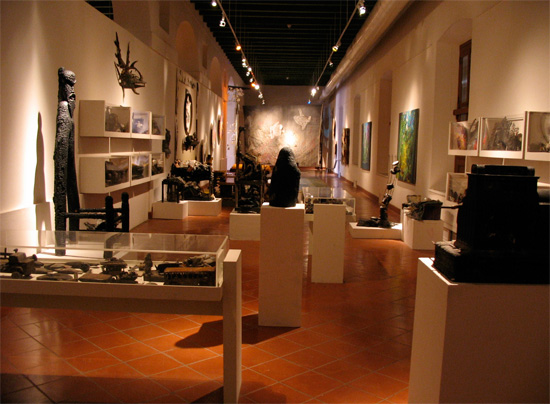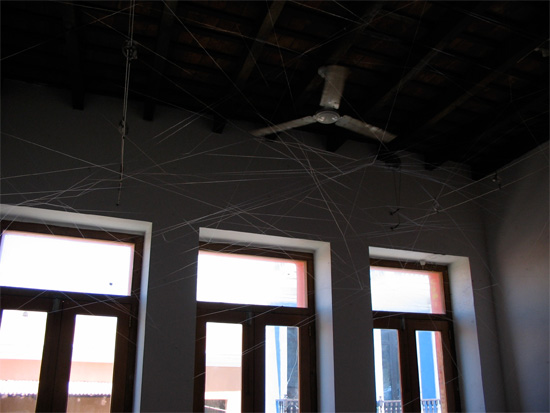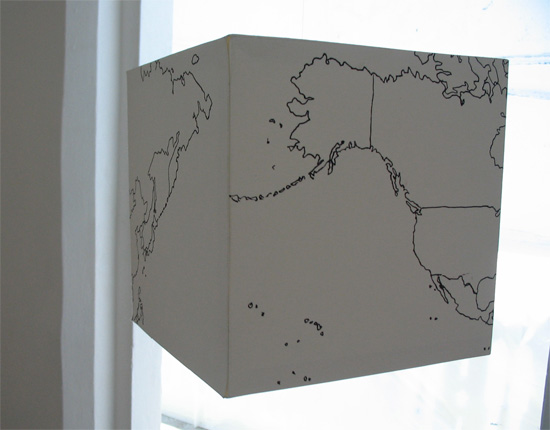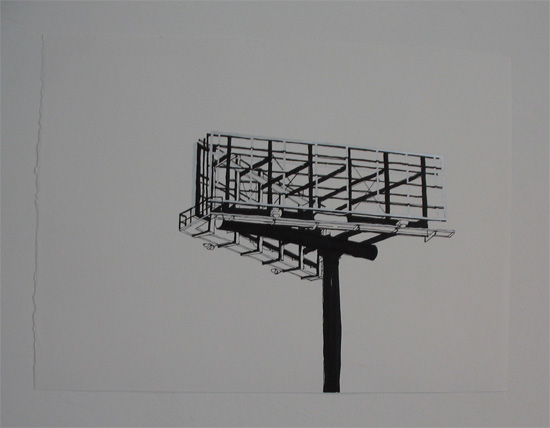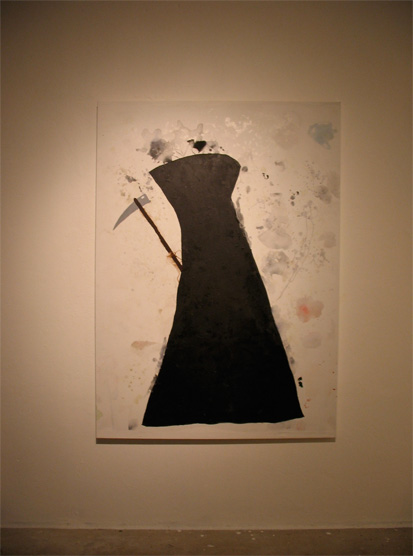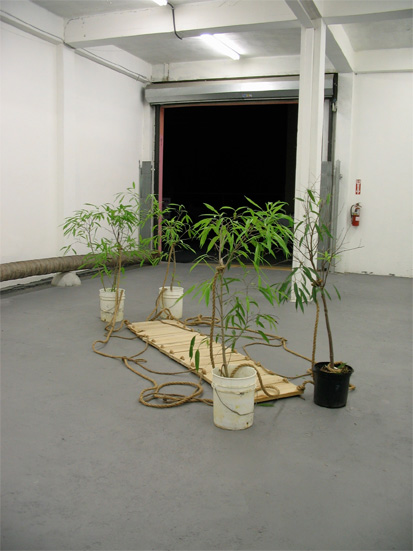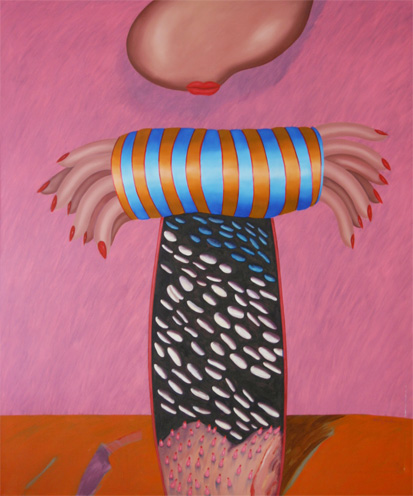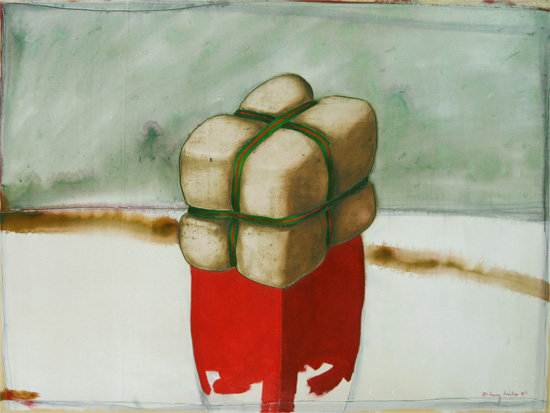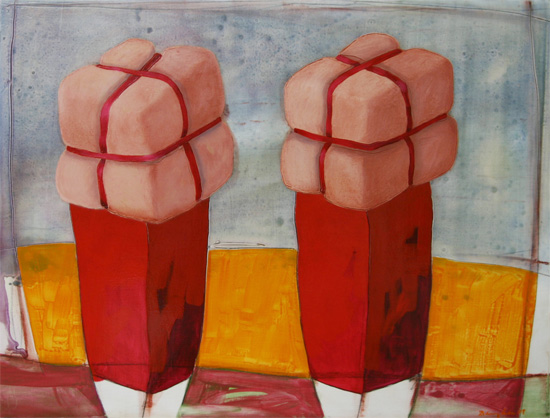
UnstoppableWe think of Antonio Martorell as an admirable character in the Puerto Rican cultural landscape, the closet thing the island has to a national treasure. His new exhibition at La Ballajá, Martorell: DF—or Martorell después del fuego—is both mind-bending in its scale and achievement and ineffably sad. It represents, as the artist wants you to believe judging from his text in the exhibition catalogue, a remarkable comeback; or better said, a riposte from an artist who’s suffered an almost unimaginable reversal, the destruction of a great deal of his work and many of his collected treasures by an arson fire, an act made all the more infuriating by its origins in the malignancy of short-circuited pubescence and national malaise. (This is our interpretation of events, and not, in those words, what the text has to say.)
It is hard to imagine picking oneself up from such a blow, but Martorell is a man with a fathomless, inexorable drive to act and do what he does best, what he knows and has the considerable chops for, no matter what the situation. Even in ordinary circumstances he is an unstoppable creator, obsessive, way larger than life. What’s disappointing about his new exhibition is how much La Ballajá resembles a mausoleum, the place of a dead monarch. It seems that, his protestations notwithstanding, the fire did visit upon him an irredeemable loss. You look down one of the exhibition’s great, somber halls and there is vitrine after vitrine, as if holding the inert treasures of the long-departed. And indeed, peering into the glass, you discover evidence of a very garden-variety acquisitiveness made useless: a crushed cell phone, old cameras and door latches, folk figurines and vehicles, dolls which could only be playthings. There they sit, no longer treasures you can pull out, examine, and handle with a possessor’s satisfaction, or play with as someone dreaming of childhood, or add to like a person with that kind of itch. They are now simply blackened mummies, useless things except insofar as they represent that unspeakable insolence and the way one wrestles with fate. Martorell expresses himself from the heart, with that years-refined, propulsive speech of his, in the preface to the exhibition; that desgracia has gracia within it, is its very root. His words are incandescent; they reach into the artist’s soul and the heart of his country. How true to the words it might have been to leave it at that for once, to let the words alone echo in a vastness filled with little more than future possibility. Don’t miss the opportunity to see what we mean firsthand by visiting the second floor of el Museo de las Américas at La Ballajá in Viejo San Juan, sala 2. It’s open, we believe, from 10 a.m. to 4 p.m. weekdays, possibly not Monday but maybe Saturday. While you’re there, check out sala 3 for Terruño y paraíso perdido, an ample show of contemporary Puerto Rican artists responding to the work of Cagueño Carlos Osorio. Additionally, you’ll see that the building is a colonial-era beauty. Admission is always gratis. Piling desgracia upon desgracia, El Nuevo Día is trying mightily to trivialize Martorell’s tragedy by running successive days of news items, gossip page photos, contrived reviews on the heels of photo-op previews, as if undertaking a branding campaign for a new, different, and better kind of bank account, or launching a candidate headlong into the primary season. It is difficult enough anymore to differentiate advertising from what we laughingly used to call “the news hole,” but El Nuevo Día blurs the line mercilessly, shamelessly. We could suffer multiple heart attacks getting worked up about what is surely one of the worst daily newspapers it’s been our misfortune to live with in thirteen years of south- and eastward migration, save the notoriously thin Austin American Statesman, but what a trivial thing to suffer for. Better to celebrate the curious, genial occurrences that Puerto Rico daily puts in our way. For example, Galería Candela, or rather the exhibition program there called Art Tracking, appears to have run its brief, frantic course, and it did so with a bang. Abdiel Segarra, who organized the summer-long marathon of individual and group shows, informed us that Javier Olmeda Raya’s the invisible landscape/drawing loops is not only the final show of a series, but the end of the program as far as he’s concerned.
It’s too bad, since Galería Candela offered young artists an opportunity, no matter how brief, to exhibit their work, have a party, and get some booty: buttons, posters, t-shirts, plus the adoring coverage of several web sites. In Segarra, the program had one of the smartest, hardest working, and straightest shooting organizers on the scene, though you could read the fatigue in his eyes as the summer wore on, and the frustrations that come with doing a great deal where the rewards are few and paltry. To our way of thinking, Olmeda Raya’s drawing show was one of the program’s best: unpretentious but loaded with ideas and skills. Also that vital ingredient, a highly developed sense of playfulness. Note the cubic “globe” below. The love of the quotidian marks the artist as a true bohemian, just as Beatriz Santiago Muñoz is (see the second image below, one of Olmeda Raya’s deadpan pen-and-ink drawings), and the web of fishing leader which constitutes his wall-to-wall drawing-in-air (above, the invisible landscape) is a bravura act, the best we hope for from our artists. Segarra assured us there is not prefigured pattern to the work; yet it has a balance and logic all its own. If you’re very lucky, it’s not been dismantled yet and Segarra is available to show you around: 787-633-9422. The Galería Candela web site is here.
We’re sorry to see Art Tracking go its way, but we don’t believe we’ve seen the last of its kind. Down the road, and around a few bends if you want to be literal about it, Galería Comercial is showing new paintings by Fernando Pintado, and Pintado’s work is much transformed since the last time we looked, about ten months ago. He seems to have gone on a strict aesthetic diet—the kind Antonio Martorell might consider—because his canvases, once running over with notes, aphorisms, and other wry and rueful scribblings, not to mention scattered visual annotations, now find themselves bereft. Gone are the texts, the miscellaneous figures and imaginary diacritical markings, much of the color, and a lot of the detail that once gave his paintings a lift. In their places, a few declarations of a distinct discouragement and equally baleful-looking characters and tableaux: lost-looking duck, depressed snowman, wilting flower, skull and crossbones daring you to “sing me a melody.” There is a nuclear tower holding Death’s scythe. Is it the war in Iraq? Quite the fork in the road for Pintado.
On the other hand, Michael Linares’s potted-palm-and-useless-bridge, Wait Till It Grows (Hanging Bridge), is looking better to us for some reason, as the trees perk up with the onset of cooler weather perhaps. We’re starting to cozy up to the idea.
Visit the gallery and take a look at all this, plus, as usual, a Perros Negros enterprise in the project room, at Avenida Fernández Juncos #1600. Call 787-726-1065 or 787-217-5848, send an email, or go to Galería Comercial’s web site.
In faraway Ponce, that rarely perky, oft-fled place, Galería Trinitaria is doing what it can to bring some joy to Mudville. An exhibition of new paintings and drawings by Ponceño André Rodríguez Santos opened there not long ago, Compendio Medios Mixtos, and, as you see, it’s nail-polish bright and leans toward an old-fashioned and not unfriendly surrealism. The closer to abstraction these quite sizable mixed-media works are, the more inclined we are to enjoy them. The exhibition includes a few exquisitely subtle pastel drawings, of which, unfortunately, we have no images to show you. Herewith are some more or less representative paintings, however, courtesy of the gallery. The work above is titled Ente luminoso, oil on linen, 50" x 70", 1998. Below: Monumento a la Opressión and Monumento a la Opressión 2, both mixed media on wood, 24" x 32", and painted in 2007.
We encourage you take the journey south, a not unpleasant drive if you don’t do it more than once in a blue moon. There are, we are not supposed to say aloud, two excellent once-in-a-lifetime exhibitions at the unnamed museum in Ponce, some French sculptor who is only one of the nineteenth century’s greatest, and an equally provocative installation of contemporary work amidst the Old World masterpieces by the incomparable you-should- know-who. Once you pull into town, you can start off at Trinitaria and shake hands with director Felix Rivera, who is doing his best to liven things up with the help of his able administrator, Felix Garmendia Santos. Then it’s off to the museum, followed by a visit to Kings Cream and a cup of the best joe on the island, Cafe Mayor. Buen viaje. Galería Trinitaria is located at 2980 Avenida Fagot, the phone number is 787-259-1034, and the gallery has a web site which you can access here. Whatsitsname Museum is on Avenida las Américas, but we’re not saying where. Use Google to visit the web site. A final whisper about a worthwhile show in the San Juan area. Maribel Canales is showing drawings and paintings in a relatively out-of-the-way but picturesque place, Museo Casa Blanca, at the end of a narrow byway in Viejo San Juan. We were alerted to this show by Javier Martínez on his excellent blog autogiro, and we subsequently paid the museum a visit. We see an affinity between Canales’s work and Martínez’s, and that’s a good thing. Visit autogiro and scroll down a bit to his September 5 post, and he will fill you in on the important details, including an image or two for your delectation. He says the show is up until September 30. Please come back and see us again. Feel free to try our new, if primitive, comments feature. How bloggish can you get? Tell us if you think we’re overdoing it. Head on home, and go anywhere from there. |

